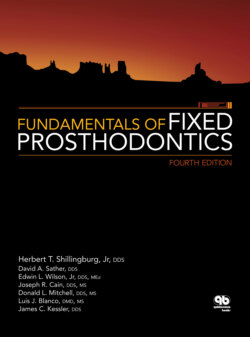Читать книгу Fundamentals of Fixed Prosthodontics - James C. Kessler - Страница 90
Complex amalgam
ОглавлениеAmalgam augmented by pins or other auxiliary means of retention can be used to restore teeth with moderate to severe lesions in which less than half of the coronal dentin remains (Fig 6-9). Amalgam used in this manner can be employed as a definitive restoration when a crown is contraindicated because of limited finances or poor oral hygiene. It can be used in the restoration of teeth with missing cusps or endodontically treated premolars and molars—teeth that ordinarily would be restored with mesio-occlusodistal (MOD) onlays or other extracoronal restorations. In such situations, amalgam is used to replace or overlay the cusp to provide the protection of occlusal coverage. Although amalgam produces good strength in the restored tooth,10 ideally a crown should be constructed over the pin-retained amalgam, using it as a core, or foundation restoration.
Fig 6-6 Composite resin is commonly used to restore Class III and Class V lesions on anterior teeth.
Fig 6-7 Indirect inlays of composite resin can be used for proximo-occlusal restorations on posterior teeth.
Fig 6-8 A simple amalgam restoration placed in an MOD preparation on a molar.
Fig 6-9 A complex amalgam restoration replaces a missing cusp on a molar.
Fig 6-10 A metal inlay is used to restore a molar.
Fig 6-11 Ceramic inlays can be used to restore posterior teeth.
Fig 6-12 An MOD onlay for a maxillary premolar.
